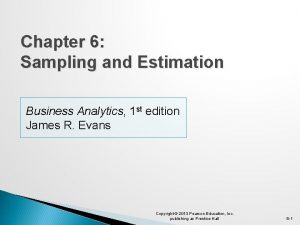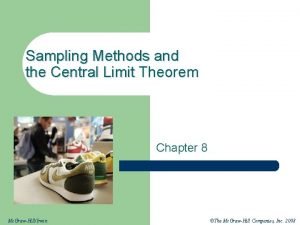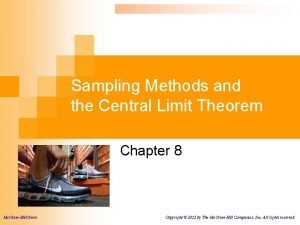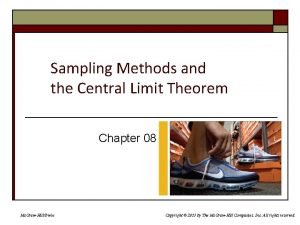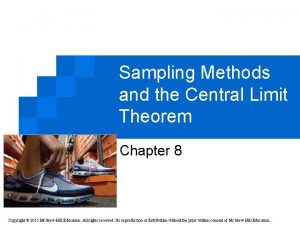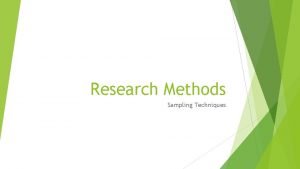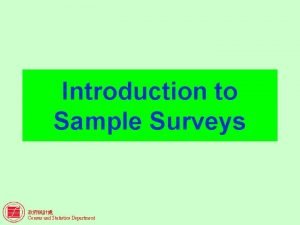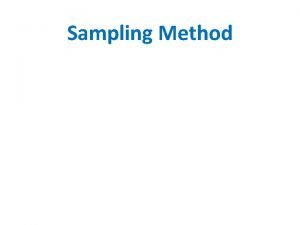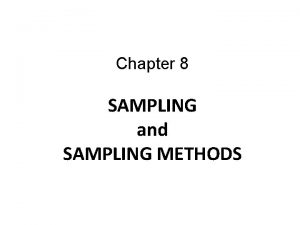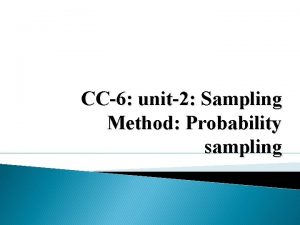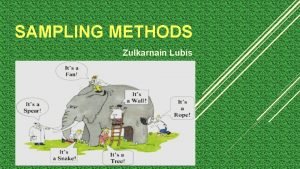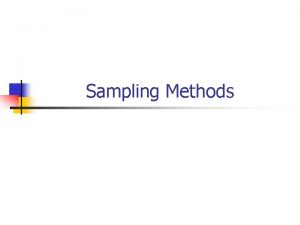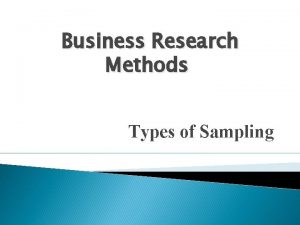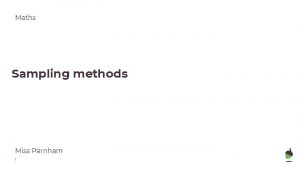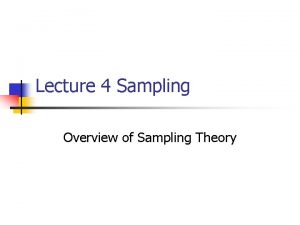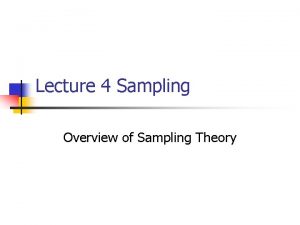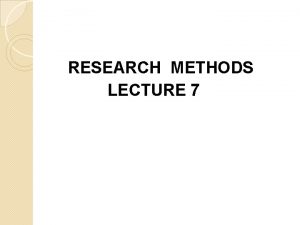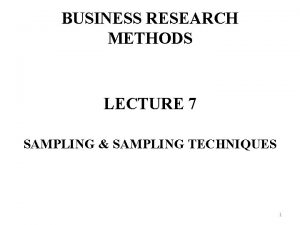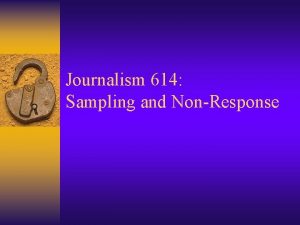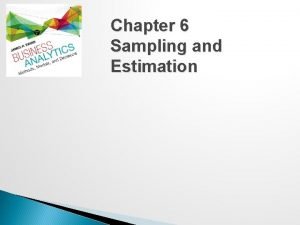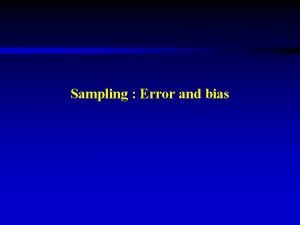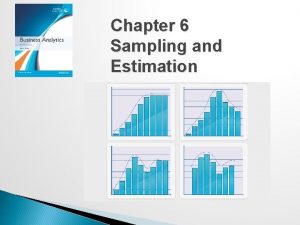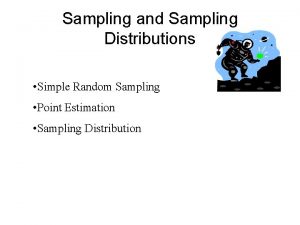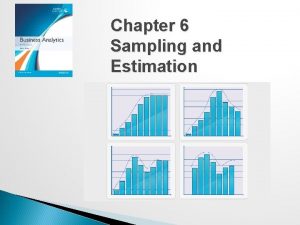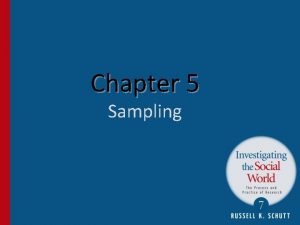LECTURE 04 SAMPLING AND ITS METHODS SAMPLING A

























- Slides: 25

LECTURE # 04 SAMPLING AND ITS METHODS

SAMPLING A method or process of selecting some part of a group to represent the total. ü Total group is called as population ü Part of the total group that is selected is called as sample. The process which involves taking a sub-group of the population, making observation on this representative group and then generalizing the findings to the bigger population is termed as sampling.

POPULATION Defined aggregate of persons, objects or events that meet a specified set of criteria. Larger group to which research results are generalized Populations are not necessarily restricted human subjects, May include people, places, organizations, objects, animals, days or any unit of interest. For Example ü Housing units in a household survey ü Blood samples in an medical study ü Inventory of manufactured products in industry

SAMPLE Sub-group of the population. Serves as reference group for estimating characteristics or drawing conclusions about the population.

PARAMETER AND STATISTIC A PARAMETER is a characteristic or measure obtained by using the data values from a specific population. ü Greek letter is used to symbolize the parameter. ü E. g. the "average" age at time of admission for all students. A STATISTIC is a characteristic or measure obtained by using the data values from a sample. ü English alphabet is used to symbolize the statistic. ü E. g. the "average" height, found by using the set of 25 heights.

ADVANTAGES OF SAMPLING No need to get information about everyone Save time. Reduces the length of time needed to finish study Save money Save energy Less data so limited error (fewer opportunities to make mistake) — Improved quality Better supervision and record keeping

METHODS OF SAMPLING Probability sampling ü Every element in the population has equal probability of selection in the sample. ü Involves random selection at some point. Non-Probability sampling ü Every item in a population does not have an equal chance of being selected. ü Selection of samples is based on personal judgment. ü Convenient and economical ü Quality depends on knowledge, judgment and expertise of researcher

METHODS OF SAMPLING METHODS PROBABILITY SAMPLING 1. Simple Random Sample 2. Systematic Sample 3. Stratified Sample 4. Cluster Sample 5. Multi Stage Sample NONPROBABILITY SAMPLING 1. Convenience Sample 2. Quota Sample 3. Snowball Sample 4. Judgement Sample

SIMPLE RANDOM SAMPLING Randomly selecting a sample in such a way that every item in a population has an equal chance of being included in the sample. Easiest and least complex Suitable for homogeneous population The personal bias of the researcher is not involved.

Cont. .

SYSTEMATIC RANDOM SAMPLING Selecting the kth item from a population with a random start k is the sampling ratio that may be computed from the following formula. k = N/n Where üN = Population Size ün = Sample Size

Cont. .

STRATIFIED RANDOM SAMPLING The population is divided into homogeneous groups and these groups are named strata. Then, a sample of specified size is selected from each strata by random sampling method. The total of sub-samples will constitute the full sample. It increases the efficiency of sampling by dividing heterogeneous population into sub-groups in such a way that there is homogeneity within groups and heterogeneity between groups. It reduces the sampling errors. Greater precision than simple random sampling.

Cont. .

CLUSTER OR AREA SAMPLING Subdivide the population into smaller clusters. Select the clusters by simple or systematic random method to makeup the overall sample. The probability of selecting an element is the probability of selecting its cluster. Different from stratified as element may be heterogeneous. (In stratified they are homogenous). Used when population is scatted over a wide area. Also known as area sampling as it is frequently applied on a geographical basis.

Cont. .

MULTI-STAGE SAMPLING If more than two stages are involved in obtaining the overall sample, it is known as multi-stage sampling. Cluster sampling and stratified sampling are the examples as two stages of sampling are involved.

CONVENIENCE OR ACCIDENTAL SAMPLING A unit is self-selected (e. g. volunteers) or easily accessible/available. It is not normally representative of the target population because sample units are only selected if they can be assessed easily and conveniently Although may yield useful information, caution with making inferences.

JUDGEMENT OR PURPOSIVE SAMPLING Researcher selects the subjects on basis of specific characteristics or attributes that are important to the research study. It is ensured that subjects have appropriate knowledge and will be good informants for the study.

SNOWBALL SAMPLING Select a few subjects who meet selection criteria Ask selected subjects to identify others who have requisite characteristics Repeat process of "chain referral" or "snowballing" till adequate sample size obtained Useful if hard to locate subjects with specific characteristics

QUOTA SAMPLING In quota sampling, the population is first segmented into mutually exclusive sub-groups, just as in stratified sampling. Then judgment is used to select the subjects or units from each group based on a specified proportion. Preferable to other forms of non-probability sampling (e. g. , convenience & judgment sampling) because it forces the inclusion of members of different sub-populations.

STRATEGIES FOR DETERMINING SAMPLE SIZE Using a Census for small populations Using a Sample Size of a Similar Study Using Formula to Calculate a Sample Size

USING A CENSUS FQR SMALL POPULATION Use entire population as sample Useful for small population Eliminates sampling error Provides individual level data

USING A SAMPLE SIZE OF A SIMILAR STUDY Could be a valuable approach but without reviewing the procedures employed, may include risk of repeating errors made previously. Review literature to get guidance on "typical" sample size

USING FORMULA TO CALCULATE THE SAMPLE SIZE Yamane’s Formula n= Where n =Sample Size N = Population Size e = Level of precision or Sampling error (Percentage allowance for the non- precision because of the use of sample instead of the population) Reference: Yamane , Taro. 1967, Statistics, An introductory Analysis , 2 nd Ed. New York: Harper and Row
 01:640:244 lecture notes - lecture 15: plat, idah, farad
01:640:244 lecture notes - lecture 15: plat, idah, farad Slidetodoc.com
Slidetodoc.com Sampling and estimation methods in business analytics
Sampling and estimation methods in business analytics Sampling methods and the central limit theorem
Sampling methods and the central limit theorem Sampling methods and the central limit theorem
Sampling methods and the central limit theorem Sampling methods and the central limit theorem
Sampling methods and the central limit theorem 抽樣分配
抽樣分配 What is the sample size in qualitative research?
What is the sample size in qualitative research? Wax pattern in dentistry
Wax pattern in dentistry Types of research sample
Types of research sample Types of sampling psychology
Types of sampling psychology Audit sampling methods for tests of controls
Audit sampling methods for tests of controls Sampling methods statistics
Sampling methods statistics Sampling methods
Sampling methods The emigree poem structure
The emigree poem structure Its halloween its halloween the moon is full and bright
Its halloween its halloween the moon is full and bright Sampling method in research
Sampling method in research Cluster sampling advantages and disadvantages
Cluster sampling advantages and disadvantages Stratified sampling vs cluster sampling
Stratified sampling vs cluster sampling Yuli fajar susetyo
Yuli fajar susetyo Cluster random sampling vs stratified
Cluster random sampling vs stratified Research sampling definition
Research sampling definition Natural sampling vs flat top sampling
Natural sampling vs flat top sampling When a train increases its velocity, its momentum
When a train increases its velocity, its momentum Windy snowy rainy sunny
Windy snowy rainy sunny If its square its a sonnet
If its square its a sonnet


